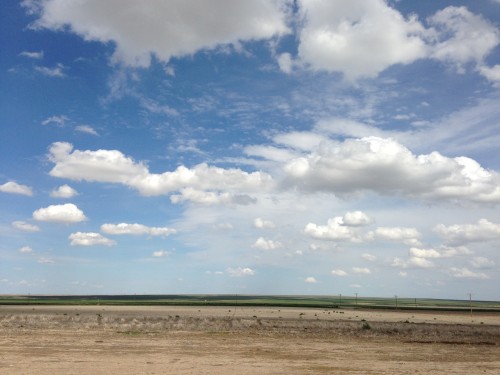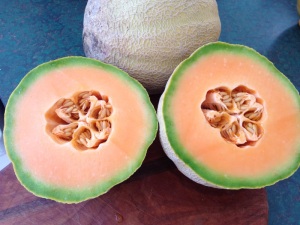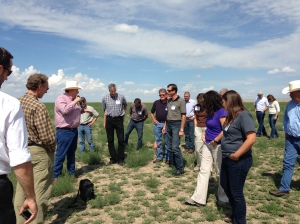 Wide open spaces, dust blowing against a dark gray soon-to-rain backdrop, a few cattle in the distance, some puddles from recent rains, green weeds or sparse grass in certain fields and the sweet smell of cantaloupe– then the taste. That was last night’s scene driving down Highway 50 from Pueblo to Lamar and back again through Colorado’s Arkansas River Basin, currently one of the driest parts of the state.
Wide open spaces, dust blowing against a dark gray soon-to-rain backdrop, a few cattle in the distance, some puddles from recent rains, green weeds or sparse grass in certain fields and the sweet smell of cantaloupe– then the taste. That was last night’s scene driving down Highway 50 from Pueblo to Lamar and back again through Colorado’s Arkansas River Basin, currently one of the driest parts of the state.
As of Monday, August 12, 2013 the Otero and Crowley County region has been designated as a drought area for 1,014 continuous days. Southeastern Colorado has faced three seasons of drought that’s been progressively worsening and people in the area have seen months of blowing dust, crop and rangeland loss and have been forced to liquidate cattle herds– they’re worried and upset. Yesterday, a bus loaded with nearly 50 state and federal employees, representatives and senators, other local and regional managers and decision-makers who attended the Colorado Water Conservation Board‘s Arkansas River Basin Drought Tour also saw it.
“I’d like to thank all of you guys for coming down and looking at our drought,” said Colin Thompson before discussing the Arkansas River Compact. This bus of decision makers heard about the problems with blowing dust and the Soil Erosion- Dust Blowing Act, impacts on agricultural producers, wildlife impacts, different farming techniques and concern from residents.
The landscape didn’t look as dry as it has been. Southeastern Colorado has seen 2-8 inches of rain over the past six weeks which has done little for surface water supply but helps with demand, and has provided enough moisture to start grasses and weeds and to hold down some of that dust. “There are mud puddles which we dreamed would happen,” said Colorado State Climatologist Nolan Doesken. “They’ve finally happened here.”
Some portions of Southeastern Colorado experienced a level of drought classification in October 2010, by March 2011 it was considered severe and by May 2011, conditions were extreme and exceptional. By early 2012 conditions improved but declined again, back to severe by late June 2012. 2012’s high spring and summer temperatures resulted in record breaking evapotranspiration rates and very dry soil– soil moisture levels remain very low. According to a fact sheet provided to tour participants, the current drought is comparable to, and in some parts of southeastern Colorado worse, in intensity and duration to the most severe portion of the 1930s and 1950s droughts. Although the area has received recent precipitation, the drought is far from over.
Area producers are seeing economic impacts– the 2013 winter wheat crop was almost nonexistent, corn planting for 2013 was less than 5 percent of average and there’s been at least an 80 percent loss of rangeland– projected crop loss for the region is more than $72 million. On top of that, 70-80 percent of cattle in the area have been liquidated or relocated. The impact is wide ranging and producers worry that they haven’t seen the end of it.
Then, there are concerns about dust and the cost of dust suppression. Throughout the CWCB’s tour, various producers, county commissioners, attorneys and others pointed to the faults of the Soil Erosion and Dust Blowing Act which can bring producers $15 per acre for dust suppression. “The $15, in a lot of cases, won’t allow the guy to turn on a tractor,” said Rich Rhoades with the U.S. Department of Agriculture’s Natural Resources Conservation Service. Marci Day with the Pueblo County Attorney’s Office echoed those concerns, “It’s definitely, I think, an outdated act.” By the end of the tour, a community meeting in Lamar gave producers another chance to speak up. John Stulp, special policy adviser to the governor on water and rancher, responded to concerns about this act. “We’ve heard it enough today. [The act is] archaic. It’s out of date. We need to modernize it,” Stulp said. “We’ll continue this conversation.”
 Concerns were voiced and seen, decision makers went home with new contacts, phone numbers and issues to follow up on– and everyone left with a couple melons.
Concerns were voiced and seen, decision makers went home with new contacts, phone numbers and issues to follow up on– and everyone left with a couple melons.
Related articles
- Drought news: Monsoon moisture helps but southeastern Colorado is still behind for the water year #COdrought (coyotegulch.wordpress.com)
- Arkansas River Basin update on Colorado River Basin imports this season #ColoradoRiver #COdrought (coyotegulch.wordpress.com)
- Arkansas River Basin: ‘…good whitewater conditions should continue through at least mid-August’ – CPW (coyotegulch.wordpress.com)
- Drought conditions persist across much of Colorado (summitcountyvoice.com)


 Print
Print
Reblogged this on Coyote Gulch and commented:
Don’t fail to click on the graphics.